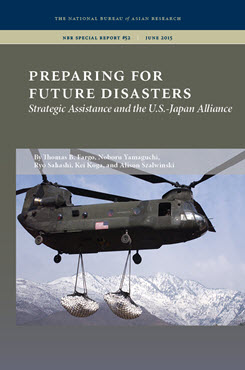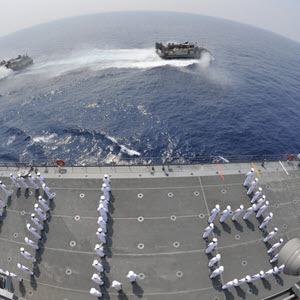NBR Special Report no. 52
Preparing for Future Disasters
Strategic Assistance and the U.S.-Japan Alliance
This NBR Special Report examines the challenges posed by major disasters in the Asia-Pacific and argues that the United States and Japan need to elevate humanitarian assistance and disaster relief to be a key component of their combined regional security strategy.
Download the Japanese version
EXECUTIVE SUMMARY
Faced with the threat of increasingly frequent and destructive large-scale disasters in Asia, Japan and the U.S.—owing to their unique capabilities and shared interests within the region—need to elevate humanitarian assistance and disaster relief (HA/DR) operations to be a key component of their combined regional security strategy.
MAIN ARGUMENT
The Strategic Assistance concept seeks to apply some of the lessons of recent HA/DR operations to U.S. and Japanese strategies, plans, and postures for future disaster responses in South and Southeast Asia in a whole-of-society, joint U.S.-Japan approach. With factors such as geography, geology, extreme weather, environmental change, climate change, socioeconomic trends, and economic progress contributing to a shifting threat environment within South and Southeast Asia, regional states recognize the need for improvements in multilateral coordination on disaster preparedness and response. While many of these states benefit from U.S. and Japanese involvement in HA/DR activities, they have varying perceptions of and concerns about the U.S. and Japanese role in providing assistance. It remains clear, however, that given military, civilian government, and private-sector capabilities, the U.S.-Japan alliance is an ideal platform to deliver enhanced HA/DR operations in Asia. While keeping in mind challenges such as fiscal constraints, sovereignty concerns, and political dynamics, the Strategic Assistance concept envisions the U.S. and Japan working together to build resilience, strengthen response, and enhance recovery in HA/DR operations.
POLICY IMPLICATIONS
- Resilience. The U.S. and Japan should focus on developing approaches to increase coordination and cooperation on programs that stand to enhance the ability of vulnerable nations to withstand major disaster events.
- Response. The U.S. and Japan should enhance combined communications, decision-making, and action-coordination capacity across a range of actors.
- Recovery. As stability is re-established and operations focus more on rebuilding essential social functions and capacities, the U.S. and Japan should invest resources in and transition back toward steady-state recovery and development programs.



